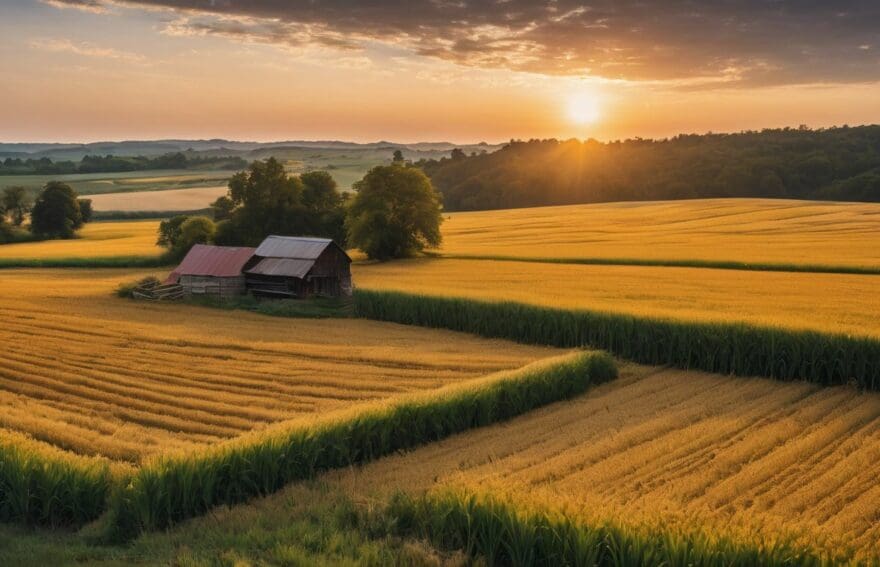Stardew Valley: The New Age of Farming Simulators

Updated On: November 18, 2025 by 
Have you ever caught yourself daydreaming about a life more tranquil, where your most pressing concern is the selection of seeds for your next harvest? Trust us, you’re not alone in this pastoral fantasy.
Fortunately, we’ve stumbled upon Stardew Valley – a delightful escape that allows one to embrace the rustic charms of farming life. Our forthcoming blog post serves as your trusty guide through this enchanting realm where nurturing crops goes hand in hand with cultivating friendships and honing one’s crafts.
So why not pop on your wellies, join us amidst the furrows and hedgerows, and let’s grow together in spirit and in virtual soil!
The Evolution of Farming Simulators
Farming simulators have come a long way from their traditional roots, evolving into modern open-ended RPGs like Stardew Valley. This shift has revolutionised the genre and introduced new gameplay elements that have captured the interest of both hardcore gamers and casual players.
From traditional to modern
As we delve into the world of farming simulation games, it’s crucial to acknowledge how they’ve transformed over time. Gone are the days when such games were limited to basic crop planting and animal rearing.
Today’s agricultural simulators like Stardew Valley bring layers of depth and complexity that were previously unimaginable. They combine the rustic charm of rural life simulation with cutting-edge gameplay content, inviting players not just to cultivate land but also relationships.
Stardew Valley stands at the forefront of this transformation, revolutionising what it means to manage a virtual farm. Players inherit a farm plot, breathing new life into its hand-me-down tools and prehistoric farming methods by crafting machines or diving into scientific pursuits with local flora and fauna.
As we witness this shift from simplistic country living simulations to diverse agricultural RPGs, let us prepare for the rise of Stardew Valley in our next discussion.
The rise of Stardew Valley
Stardew Valley emerged as a game-changer in the farming simulation genre, developed by Eric “ConcernedApe” Barone. Players step into the shoes of an heir who inherits a rundown farm and must cultivate it to create a new life.
The game’s blend of open-ended gameplay, hand-me-down tools, and stone-age farming techniques offers players a nostalgic but fresh experience. Stardew Valley goes beyond traditional agricultural management games with its focus on personalisation and community-building options, distinguishing itself from other virtual farming experiences.
The rise of Stardew Valley has impacted the gaming industry significantly since its release. Its success is evident through high sales figures and positive reception among both devoted fans and newcomers to farm management games.
Stardew Valley: A Game-Changing Farming Simulator
Stardew Valley has revolutionised the farming simulator genre with its open-ended gameplay, hand-drawn visuals, and delightful soundtrack. This game has been highly praised for its relaxing and immersive experience, drawing in players from all walks of life.
Features and gameplay
Stardew Valley offers a plethora of features, ranging from farming and animal husbandry to mining and fishing. Players can cultivate their farm plot inheritance using hand-me-down tools while immersing themselves in the Stone Age farming experience.
The open-ended RPG allows for extensive personalisation, enabling players to carve out their own homesteading simulation within the game’s world. The gameplay also involves forming relationships with townspeople, participating in seasonal events, and uncovering secrets about the town’s history, contributing to an engaging country life experience.
In addition to traditional agricultural activities like tending animals and growing crops, Stardew Valley incorporates elements of adventure and exploration as players delve into mines teeming with resources and monsters.
Positive reception and impact on the genre
Stardew Valley’s impact on the gaming industry has been profound. The game’s positive reception has sparked a surge in interest and innovation within the farming simulator genre. Its open-ended gameplay, charming characters, and immersive world have set a new standard for agricultural games, enticing both seasoned gamers and newcomers to experience the joys of digital farming.
The game’s success has also prompted developers to explore new avenues for storytelling and player interaction in similar titles. With its emphasis on personalisation and community building, Stardew Valley has redefined the possibilities for farming simulators, inspiring a wave of creativity among indie developers who seek to capture the essence of rural life in their own unique ways.
The Proliferation of Stardew Valley-Inspired Games
The success of Stardew Valley has inspired a wave of indie farming simulators, each putting its own unique spin on the genre. These games offer diverse gameplay experiences and provide an exciting alternative for fans of the farming simulator genre.
The success of indie farming simulators
Indie farming simulators have seen a surge in popularity, with games like Stardew Valley leading the charge. These titles offer players a chance to escape into virtual farms, creating their own unique agricultural experiences.
The success of indie farming simulators lies in their ability to deliver relaxing and engaging gameplay that allows for creativity and personalisation. Players can explore diverse farm management mechanics while immersing themselves in charming visuals and soothing soundtracks, making these indie gems stand out from mainstream titles.
Moreover, indie farming simulators often provide a sense of community within the gaming world, allowing players to share tips and strategies through forums or social media groups. As a result, these games foster an inclusive environment where gamers can connect over shared interests and collaborate on creative projects within the game.
This vibrant community aspect has contributed significantly to the rise of indie farming simulators as beloved alternatives to traditional gaming experiences – igniting a passion for virtual agriculture among players of all ages.
How they differ from Stardew Valley
Stardew Valley-inspired games set themselves apart by introducing unique gameplay mechanics and features to differentiate from the original. Some offer a more in-depth focus on specific aspects of farming, such as animal husbandry or crop management, providing a niche experience for players seeking a different playstyle.
Others diverge by incorporating fantasy elements, adding magical creatures or supernatural events into the farming simulation. These variations cater to diverse player preferences and expand the genre’s appeal beyond traditional farming activities.
Additionally, these games often explore alternative settings and themes, deviating from Stardew Valley’s rural farm life. Some may immerse players in coastal fishing villages, while others transport them to futuristic or otherworldly environments.
Why Stardew Valley Stands Out
Stardew Valley stands out for its extensive personalisation and customisation options, allowing players to truly make their farm and experience their own. The game also focuses heavily on building relationships and community within the game, creating a deeper sense of immersion for players.
Personalisation and customisation options
Players can personalise and customise their farms in Stardew Valley in numerous ways, from designing the layout of their farm to choosing where buildings are placed. Furthermore, players have the freedom to grow different crops and raise various animals based on their preferences.
They can also upgrade and customise their tools for efficiency and effectiveness. Additionally, players can decorate their homes with furniture, wallpapers, and flooring according to their taste, allowing for a unique living space reflective of each player’s individual style.
Moreover, players also have the option to engage with other characters in the game by building relationships through conversations and gifts. These interactions provide opportunities for players to shape both their character’s story as well as those of other non-playable characters within the virtual community.
Focus on relationships and community
Stardew Valley offers a unique focus on relationships and community, allowing players to build friendships, form romantic relationships, and contribute to the development of the local town.
By engaging with townspeople through conversations, quests, and events, players can deepen their connections and unlock new gameplay opportunities. The game also incorporates festivals and events that bring the community together, fostering a sense of belonging and camaraderie among characters.
As players interact with villagers and participate in communal activities, they contribute to the growth and vibrancy of Stardew Valley’s social fabric.
This emphasis on relationships and community adds depth to the gameplay experience, immersing players in a richly developed world where meaningful interactions shape both individual experiences and the collective narrative.
Through these interconnected relationships with NPCs (non-player characters), gamers can access additional content while contributing to an overall sense of cohesiveness within the game’s virtual society.
Conclusion: The Future of Farming Simulators
The future of farming simulators looks bright, with the potential for even more immersive and interactive gameplay. Stardew Valley has set a high standard for the genre, and we can expect to see more innovative and creative farming simulation games in the years to come.
The potential for future improvements in the genre
Stardew Valley has set a high standard in the farming simulation genre, paving the way for future improvements. With its open-ended gameplay and focus on community, there is an opportunity for developers to further enhance player customisation options, allowing for even more personalisation and creativity.
There’s also potential for expanding on the interactive relationships within the game to create deeper and more realistic interactions with non-playable characters.
Moreover, as technology advances, there is room for integrating more sophisticated mechanics into farming simulators. This could include enhanced AI for animal behaviour or weather patterns that have a significant impact on crop growth.
As Stardew Valley continues to inspire new games in the genre, it’s exciting to anticipate how these future developments will shape the next generation of farming simulators.
The lasting impact of Stardew Valley on the gaming industry
The potential for future improvements in the genre opens up new possibilities for gaming experiences. Stardew Valley, with its open-ended farming RPG concept, has revolutionised the simulation gaming landscape and left an indelible mark on the industry.
Its innovative gameplay mechanics and captivating storytelling have set a new standard for farming simulators, inspiring developers to explore fresh ideas and enhance player engagement.
The lasting impact of Stardew Valley can be seen in the proliferation of indie farming simulators that draw inspiration from its success, offering diverse narratives and unique gameplay elements that cater to a wide audience.
Stardew Valley’s influence extends beyond its immediate genre, pioneering a shift towards immersive storytelling and personalised experiences in video games. The game’s emphasis on hand-me-down tools and cultivating a new life has influenced titles across various genres, highlighting the enduring legacy it has carved out within the gaming industry.
FAQs
1. What is Stardew Valley?
Stardew Valley is an open-ended farming RPG where you use hand-me-down tools to turn a run-down farm into a thriving homestead.
2. How does Stardew Valley compare to games like Harvest Moon?
While Stardew Valley draws inspiration from classic games like Harvest Moon, it brings new depth with its unique characters, diverse activities, and modern gaming elements.
3. Can I create my own adventure in Stardew Valley?
Absolutely! The game’s open-ended design means you can choose your own path and style of farming, build relationships with villagers, or explore various mysteries at your own pace.
4. Is there more to do in Stardew Valley than just farming?
Definitely! Beyond tending crops and livestock, you can engage in fishing, mining, crafting, attending village festivals and much more as you shape your character’s life in the valley.









